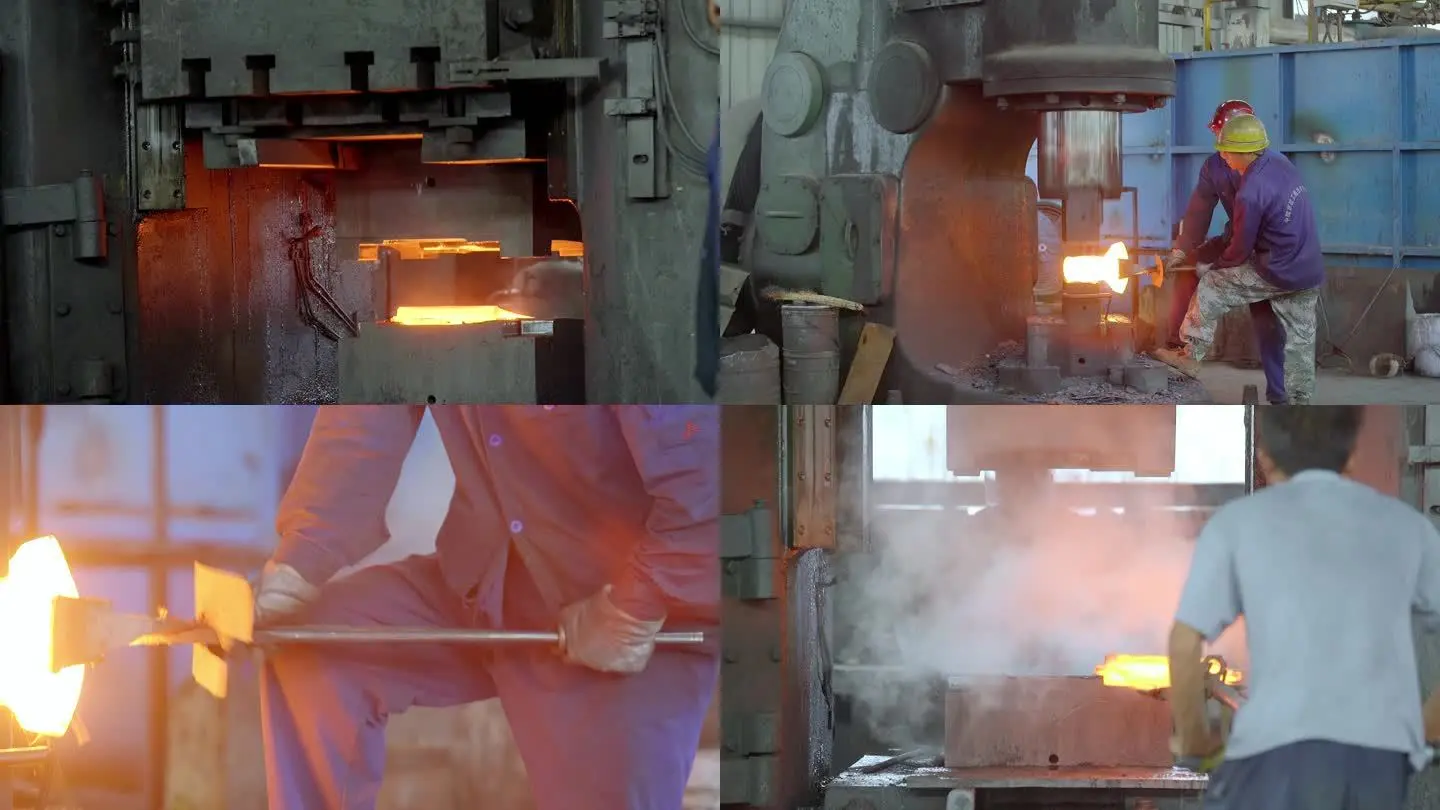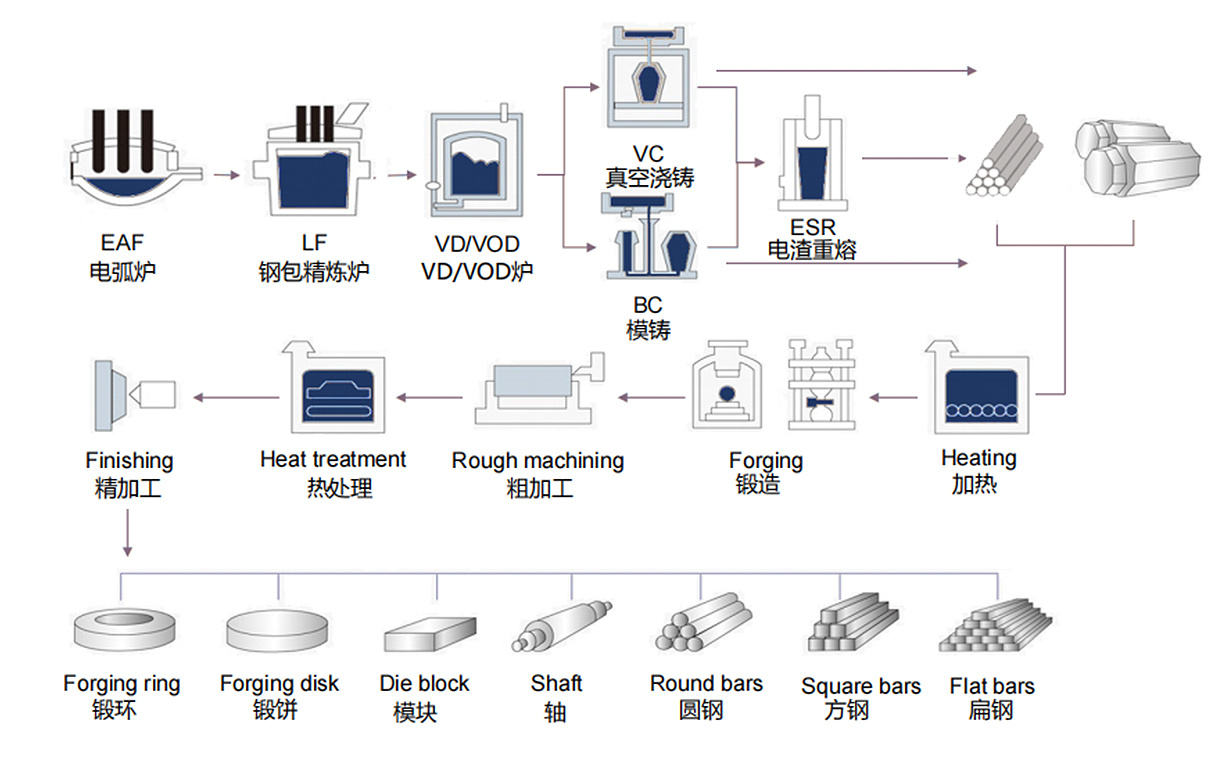Forgiatura
La forgiatura è un metodo di lavorazione che utilizza macchine per la pressatura per applicare pressione su un pezzo di metallo grezzo, causandone la deformazione plastica al fine di ottenere un componente forgiato con determinate proprietà meccaniche, forma e dimensioni. È una delle due componenti principali della lavorazione per pressatura (forgiatura e stampaggio). Attraverso la forgiatura, è possibile eliminare difetti come la porosità dello stato di fusione generati durante il processo di fusione del metallo, ottimizzando la struttura microstrutturale. Inoltre, poiché viene preservata l'integrità del flusso metallico, le proprietà meccaniche dei componenti forgiati sono generalmente superiori rispetto a quelle dei componenti fusi realizzati con lo stesso materiale.
La temperatura di ricristallizzazione dell'acciaio è di circa 727°C, ma si utilizza comunemente 800°C come linea di demarcazione: al di sopra di 800°C si parla di forgiatura a caldo; tra 300°C e 800°C si parla di forgiatura a tiepido o semi-caldo; mentre la forgiatura eseguita a temperatura ambiente è chiamata forgiatura a freddo. La maggior parte dei componenti forgiati utilizzati in vari settori industriali sono realizzati mediante forgiatura a caldo. La forgiatura a tiepido e a freddo è principalmente utilizzata per la produzione di componenti automobilistici e macchinari generali, consentendo un risparmio efficace dei materiali.
In base al meccanismo di formatura, la forgiatura può essere suddivisa in forgiatura libera, forgiatura in stampo, laminazione ad anello e forgiatura speciale.
I materiali utilizzati per la forgiatura sono principalmente acciai al carbonio e acciai legati, seguiti da alluminio, magnesio, rame, titanio e loro leghe. Gli stati iniziali dei materiali possono essere barre, lingotti, polveri metalliche o metallo liquido.
Rispetto ai componenti fusi, il metallo lavorato mediante forgiatura migliora la sua struttura e le proprietà meccaniche. La struttura di fusione, dopo la deformazione termica attraverso la forgiatura, trasforma i grossi dendriti e i cristalli colonnari in una struttura ricristallizzata con grani più fini e uniformi. Ciò compatta e salda difetti come segregazioni, porosità, bolle d'aria e inclusioni presenti nel lingotto, rendendo la struttura più densa e migliorando la plasticità e le proprietà meccaniche del metallo.
Le proprietà meccaniche dei componenti fusi sono inferiori rispetto a quelle dei componenti forgiati realizzati con lo stesso materiale. Inoltre, la forgiatura garantisce la continuità della struttura fibrosa del metallo, allineando le fibre del componente forgiato con la sua forma esterna e mantenendo integro il flusso metallico. Ciò assicura che i componenti abbiano eccellenti proprietà meccaniche e una lunga durata. I componenti forgiati prodotti mediante forgiatura in stampo di precisione, estrusione a freddo o estrusione a tiepido sono incomparabili rispetto ai componenti fusi.
Forging is a processing method that uses forging machinery to apply pressure to metal blanks to produce plastic deformation to obtain forgings with certain mechanical properties, certain shapes and sizes, and is one of the two major components of forging (forging and stamping). Through forging, the defects such as loose casting state generated by the metal in the smelting process can be eliminated, the microstructure structure can be optimized, and the mechanical properties of forgings are generally better than castings of the same material due to the preservation of complete metal streamlines.
The initial recrystallization temperature of steel is about 727 °C, but 800 °C is generally used as the dividing line, and hot forging is higher than 800 °C; Between 300~800 °C is called warm forging or semi-hot forging, and forging at room temperature is called cold forging. Forgings used in most industries are hot forging, warm forging and cold forging are mainly used for forging parts such as automobiles and general machinery, and warm forging and cold forging can effectively save materials.
According to the forming mechanism, forging can be divided into open forging, die forging, ring grinding, and special forging.
The forging materials are mainly carbon steel and alloy steel of various compositions, followed by aluminum, magnesium, copper, titanium, etc. and their alloys. The raw state of the material is bar, ingot, metal powder and liquid metal.
Compared with castings, the microstructure and mechanical properties of metals can be improved after forging. After the casting structure is deformed by hot processing by the forging method, due to the deformation and recrystallization of the metal, the original coarse dendrite and columnar grains become the equiaxed recrystallization structure with finer grains and uniform size, so that the original segregation, looseness, porosity, slag inclusion and other compaction and welding in the steel ingot, its structure becomes more compact, and the plasticity and mechanical properties of the metal are improved.
The mechanical properties of castings are lower than those of forgings of the same material. In addition, forging can ensure the continuity of the metal fiber structure, make the fiber structure of the forging consistent with the shape of the forging, and the metal streamline is complete, which can ensure that the parts have good mechanical properties and long service life, and the forgings produced by precision die forging, cold extrusion, warm extrusion and other processes are incomparable to castings.

